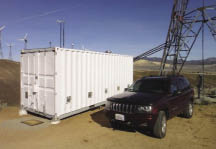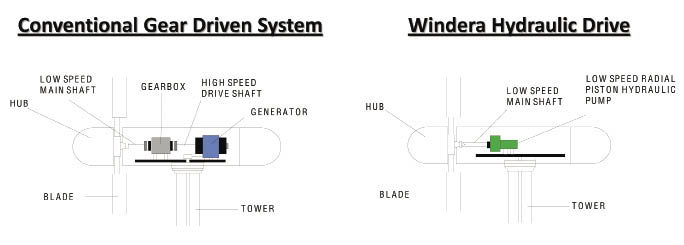
The shipping container stores the computer system, priming pump, hydraulic reservoir, hydraulic drive motor, electrical generator, and on one model, a natural-gas compressor.
The U.S. wind energy market includes roughly 30,000+ aging turbines. Of those, around 7,000 are down for repair at any given time. The bulk of repairs are gear failures in gearboxes and yaw drives. Other turbine-stoppers include main-shaft bearings and seal failures, electrical generator overloads, and over-speed brake failures. High costs and duration of repairs negatively impact wind farm ROI, not to mention, the safety risks posed by tower heights over 200 ft.
As a possible solution, Windera Power Systems has designed, built, and deployed what may be the world’s first open and closed loop hydraulic wind turbine. The system replaces the conventional electromechanical drive train with a hydraulic system that converts blade rotation into hydraulic pressure, which is then converted into electrical energy. The system directly addresses gear failures to increase reliability, efficiency, safety, and ROI. What’s more, the company says the direct drive; variable-speed hydraulics can increase the expected life of a turbine. “This technology is less costly and more efficient than conventional wind turbines. Our hydraulic system has the potential to revolutionize the offshore wind market,” says Richard Burt, CTO and Founder, Windera Power Systems, Inc.

The first open loop wind turbine differs from conventional turbines by converting mechanical blade rotation into hydraulic pressure, which is eventually converted into electrical energy.
Their idea replaces the gearbox with hydraulic drive components that have proven reliable under demanding conditions, says the company. The Windera Power design uses the rotor to drive a hydraulic pump in the nacelle which provides high-pressure fluid to a hydraulic motor at ground level. With this Down Tower Power Unit (DTPU), 90% of most mechanical components are on the ground thereby decreasing the need for a crane for many maintenance tasks. According to Windera, built-in intelligence shuts the turbine down when it encounters unsafe operating parameters. A manual shut down is accomplished by the push of one button.
Mechanical braking systems can be downsized because the hydraulics provide that feature. Automatic blade-speed regulation keeps operations within a safe range.
Battery backup eliminates power fluctuations to provide immediate and sustained power output over short periods of wind variation. The company says the system can boost or attenuate power output of individual turbines or wind parks to the specific requirements of the power utility.

The Windera Hydraulic Drive System uses no gearbox thereby eliminating gearbox-related failures.
Currently, the company is manufact-uring three systems. The Windera 300-3 is a 300 kW hydraulic drive system that uses three 100 kW wind turbines connected to one DTPU. Its focus is on repowering 65 to 100 kW turbines. The Windera 750 is a single 750-kW turbine connected to one DTPU and is aimed at repowering legacy 660 to 750-kW turbines. Lastly, the Windera Plus produces power for applications such as natural-gas compressors, water pumps, reverse-osmosis drives, electrical generators, and conveyor drives.
Filed Under: Hydraulics, News, Turbines





George Fleming says: Hydraulic drive also allows moving the generator to ground level, but this too can be achieved with gear drive.
Yes at what cost? and energy lost? Without having direct experience should not comment. Instead suggest solutions, if you can.
Hydraulic power transmission for wind turbines is a step forward for the next generation wind turbines. It is most unfortunate that some comment adversely without knowing the facts. The leakage in hydraulic transmission results when there is big pressure differential across valves or so. But the DDP use stepwise pressure increment, just like a staircase.
The most interesting point is the rotor can start spining at low cut-in wind speeds, due less mass inertia.
MITSUBISHI have demonstrated the 7 MW unit and heading for 10 MW. Bravo.
Though on some point that goes one way or the other, when purchasing hydraulic engines ( or exceeding all expectations even further , a hydraulic pump and engine) a radiator, reservoir and all the hoses, fittings, easing valve, and so on, you will have more cash used then swapping your gear box or purchasing a used bush hog.
wind blade driven by hydraulic pump. with out wind (air) the blade can rotated by with help of hydraulic pump instead air driving the blade to hydro motor.
hydraulic motor driving wind blade we can get power even without wind is avaiable or not also.
this is the reverse of instead of wind driving by hydraulics.
This is an informative article that clarifies much for me. Windera has addressed many of the existing problems that have plagued wind power equipment. Wonderful & exciting!
A statement in the Windera brochure:
“A Gearbox Loses 30-40% Efficiency through Friction”
Why would Windera make such a foolish claim? A typical wind turbine gearbox with three stages loses no more than 6-8%.
However, a combination hydraulic pump and motor, especially if operating through long pipe circuits as in the Windera system, would probably lose at least 30% of the input power at full load. I cannot accept Windera’s claim that their system is more efficient than a gear drive, even if the efficiency improvement resulting from the elimination of the power electronics is included.
Also, a well-known problem with hydraulics is leakage. The volume of hydraulic fluid in the Windera system would be large. Leaks would be very messy, they are inevitable, and a hazmat team would be kept busy on such wind farm.
Hydraulics also make a lot of irritating noise and vibrations, not easy to dampen or suppress.
A few years ago, Parker-Hannifin received some government money to develop a hydraulic drive train for wind turbines:
http://news.thomasnet.com/companystory/Parker-Awarded-Ohio-Grant-to-Advance-Wind-Energy-Technology-815815
I haven’t heard that they came up with anything worthwhile.
A comment on an article published on this website mentioned ChapDrive:
https://www.windpowerengineering.com/design/mechanical/trends-in-wind-hydraulics/
ChapDrive has published their presentation for the 2012 Husum Wind Energy Conference:
http://www.chapdrive.com/presentations/chapdrive-presentation-at-husum-2012
The only statement that I can find anywhere on the ChapDrive website regarding efficiency is that their system is “competitive.” They do make a good-looking drive train.
There is no question that the elimination of the power electronics by hydraulic drive is a major benefit. But the same can be achieved with gear drive, as DeWind has proven with their 8.2 and 9.2 turbines.
Hydraulic drive also allows moving the generator to ground level, but this too can be achieved with gear drive.
Windera has a lot of competition from ChapDrive. If Parker-Hannifin gave up on hydraulic drive, it seems unlikely that anyone else will be very successful with the concept.